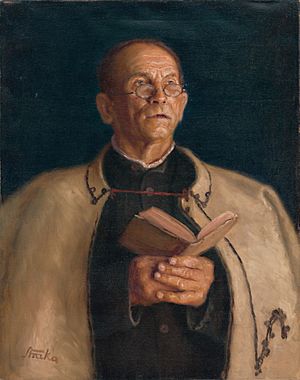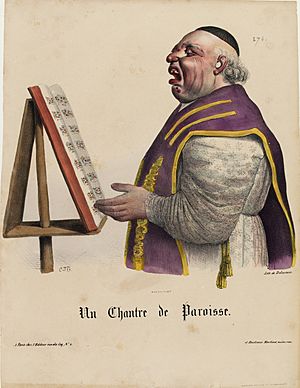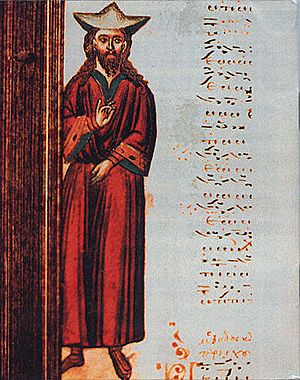Cantor (Christianity) facts for kids
A cantor is a special singer in a church. Sometimes they are called a chantress (if female) or a precentor. Their main job is to lead the singing and often teach the choir. They also help prepare the music for church services, like a Mass. The word "cantor" comes from Latin and means "singer." This role is found in Christianity, but also in some other religions like Reform Judaism and even in Ancient Egypt.
A cantor needs to be good at choosing and leading songs for the choir. They must be able to start any chant when needed. They also help singers improve and correct mistakes. Sometimes, a cantor guides the melody with hand movements, much like a music conductor.
Contents
Cantors in Western Christianity
Roman Catholic Church
In the Roman Catholic Church, a cantor used to be a very important church leader. They were the main singer of the choir.
In the Middle Ages, the main cantor of the Pope's choir was called Prior scholae. In big churches called cathedrals, the cantor or precentor was in charge of all the music and singing. They were also a high-ranking official in the church. Over time, cantors started to let other people teach the singers. After music with different parts (harmonized music) became popular, some of the cantor's jobs went to a choirmaster.
Today, anyone can be a cantor, not just church leaders. In churches without a choir, the cantor helps the people sing along. Cantors usually stand to the right of the choir. Their assistant, once called the succentor, stands to their left. In some places, cantors still carry a special staff. This staff shows their important role in the church.
Protestant Churches
In Protestant churches, a cantor can be a regular person or a church leader. In cities in Northern Europe, especially in Germany, the title "Cantor" or "Kantor" continued after the Protestant Reformation. These cantors were musicians who looked after the music in several main churches. They also taught in boys' schools and provided music for city events.
Famous musicians like Johann Sebastian Bach in Leipzig and Georg Philipp Telemann in Hamburg were cantors under this system.
In Anglican cathedrals, the precentor is a high-ranking member of the church's governing group. They are second only to the dean. The choir is often split into two sides: "decani" (the dean's side) and "cantoris" (the precentor's side).
Evangelical Churches
In some Evangelical churches, the minister who leads worship is called a worship pastor. Their job is to direct the worship during church services. They also lead practices with the worship team. Some Bible colleges offer training for worship leaders.
Cantors in Eastern Christianity
In the Eastern Orthodox, Oriental Orthodox, and Eastern Catholic Churches, a cantor is also called a chanter. This person is often a monk or a lay person who sings responses and hymns during church services. There are different titles for chanters depending on their skill. In some small communities, people sing without a teacher. In other Orthodox traditions, chanters can move up through different levels as they learn more over their lives.
Byzantine Tradition
In the Byzantine tradition, the main cantor for a service is called the protopsaltes. This title can also mean an important office within a church area. This term became common after the 12th century. The cantor or chanters sing many hymns during the Divine Services and the Divine Liturgy.
A chanter must know about the church music modes and the complex way services are structured. At Constantinople, being a protopsaltes was a very respected job. In the tradition of the Hagia Sophia cathedral, there was a leader for the right choir (Domestikos) and a leader for the left choir (Lampadarios).
Over the last few centuries, a chanter's career often started as the "Second Domestikos of the Great Church." They would then become a teacher, and later a Lampadarios. Finally, they might become the "Protopsaltes or Archon Psaltes" of the Ecumenical Patriarchate.
Vestments in Orthodox Rites
In the Greek tradition, a chanter often wears an exorason. This is a black outer robe with wide sleeves. The Slavic tradition often uses a choir instead of a single cantor. Chanters in this tradition do not have a special robe, unless they are a Reader. A Reader would wear a simple inner robe and a special white robe called a sticharion during Holy Communion.
In the Greek tradition, chanters stand at a special singing stand called a psalterion. This is usually on the south side of the church, and sometimes on the north side too. In the Slavic tradition, chanters stand in a similar area called the kliros.
See also
 In Spanish: Kantor (Cristianismo) para niños
In Spanish: Kantor (Cristianismo) para niños
- Anglican church music
- Contemporary Catholic liturgical music
- Gregorian chant
- Mass (music)




